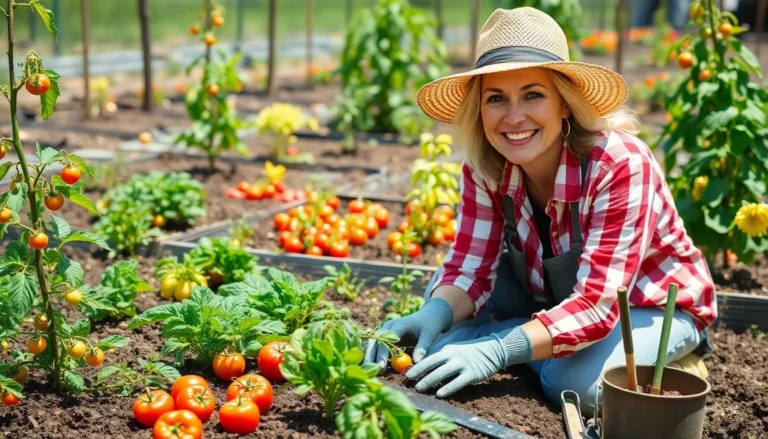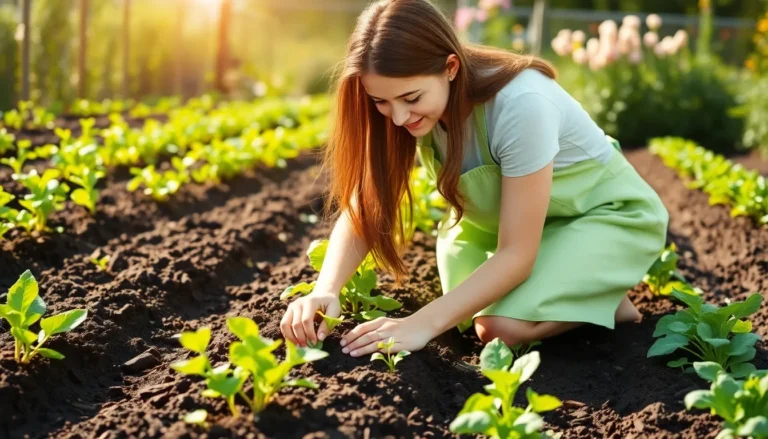As winter bids farewell and the sun begins to warm the earth, gardeners everywhere feel a familiar itch to dig in the dirt. Spring planting isn’t just a chore; it’s an invitation to unleash creativity and watch nature work its magic. Whether you’re a seasoned pro or a newbie with a questionable track record, this is the time to channel your inner green thumb and transform your garden into a blooming masterpiece.
spring planting
Spring planting provides a wonderful opportunity for gardeners to rejuvenate their outdoor spaces. Knowledge of essential factors ensures successful planting.
Importance of Timing
Timing plays a crucial role in spring planting. Many plants thrive when sown at the right moment. Soil temperature, for instance, must reach at least 50°F for optimal seed germination. Various crops, like peas and lettuce, can be planted as early as March, while others, such as tomatoes and peppers, should wait until late April or early May. Planting too early might expose young seedlings to frost, while waiting too long can result in missed growing opportunities.
Climate Considerations
Climate significantly influences spring planting success. Regional variations affect which plants thrive in specific areas. Warmer climates allow gardeners to experiment with an array of early-season vegetables and annual flowers, while cooler regions may restrict options to hardier varieties. Local frost dates dictate when it’s safe to plant tender species. Gardeners should also monitor moisture levels, as inconsistent watering can hinder growth. Knowledge of climate patterns helps them make informed planting choices.
Preparing for Spring Planting

Getting ready for spring planting involves key steps that ensure successful growth. Gardeners must focus on soil quality and seed selection.
Soil Preparation
Soil preparation remains essential for healthy plant development. Test soil pH to determine its acidity and nutrient levels. Amendments like compost or well-rotted manure enrich the soil, promoting beneficial microorganisms. Tilling the soil helps aerate it and removes any compacted areas, making it easier for roots to grow. Drainage is another critical factor; well-drained soil prevents waterlogging, which can damage seedlings. Applying mulch can conserve moisture and suppress weeds as the season progresses.
Selecting the Right Seeds
Selecting the right seeds is crucial for a productive garden. Choose seeds suitable for the local climate and soil conditions. Consider growing seasons that align with the frost dates; this ensures seeds mature properly. Heirloom varieties may offer unique flavors and resilience, while hybrids can deliver higher yields. Always check for disease-resistant options to boost overall plant health. Local gardening centers often provide insights into popular varieties, helping gardeners make informed decisions.
Techniques for Successful Spring Planting
Successful spring planting involves selecting effective methods like direct sowing and transplanting. Both techniques serve distinct purposes in the garden.
Direct Sowing vs. Transplanting
Direct sowing involves planting seeds straight into the garden bed. This method suits crops that thrive in open soil conditions, such as radishes and carrots. Gardeners appreciate the simplicity and reduced stress on seedlings. On the other hand, transplanting involves starting seeds indoors or in a controlled environment. This approach works well for plants like tomatoes and peppers, which benefit from an early start. Seedlings receive protection from pests and adverse weather conditions. Understanding the growth habits of each plant helps gardeners choose between these two planting methods.
Companion Planting Tips
Companion planting enhances garden health and productivity. Certain plant pairs, like tomatoes and basil, support each other’s growth. Basil repels pests that typically target tomatoes, creating a natural defense. Additionally, planting beans alongside corn provides nitrogen to the soil, benefiting both crops. Gardeners should consider spacing and growth patterns to maximize benefits. Mixing flowers, such as marigolds, with vegetables further deters harmful insects. Using companion planting strategies, gardeners can create a more harmonious environment in their gardens, improving yields and reducing reliance on chemical interventions.
Common Mistakes to Avoid
Failing to test soil pH represents a frequent oversight. Gardeners neglecting this step may face challenges in nurturing their plants. Not amending soil before planting can lead to poor growth and low yields. Vegetables and flowers thrive when soil conditions suit their specific needs.
Ignoring local frost dates creates unnecessary risks. Many gardeners plant too early, exposing delicate seedlings to frost damage. Monitoring these dates allows for timely planting, reducing losses.
Overwatering often leads to drainage issues and waterlogging. Many plants require well-drained soil to flourish. Applying mulch promotes moisture retention while preventing excessive saturation.
Choosing the wrong seeds reflects a significant mistake. Gardeners should select varieties appropriate for regional climates and soil types. Disease-resistant options often provide better results, ensuring healthier plants.
Omitting companion planting principles can limit garden productivity. Certain plant combinations enhance growth and deter pests while protecting resources. For instance, pairing tomatoes with basil is beneficial, as both plants thrive together.
Rushing into planting without adequate spacing affects plant health. Proper spacing is vital for airflow and nutrient access. Crowded plants often compete for resources, stunting growth and diminishing yields.
Disregarding ongoing maintenance during the growing season constitutes another common error. Regular monitoring of moisture and nutrient levels ensures optimal conditions for growth. Paying attention to fluctuating weather conditions helps gardeners adapt their care strategies.
Forgetting to rotate crops can lead to soil depletion and pest issues. Implementing crop rotation maintains soil health and reduces disease incidence. Each of these mistakes can diminish the satisfaction of a fruitful spring planting experience.
Conclusion
Spring planting offers a wonderful opportunity for gardeners to express their creativity and connect with nature. By understanding the unique needs of their plants and the specific conditions of their environment, they can create thriving gardens. Proper preparation and informed decision-making are key to a successful planting season.
As gardeners embrace the joys of spring, they should remain mindful of common pitfalls and prioritize ongoing maintenance. With dedication and care, their gardens can flourish into vibrant displays that not only beautify their surroundings but also provide bountiful harvests. This season of renewal is a chance to cultivate not just plants but also a deeper appreciation for the art of gardening.




